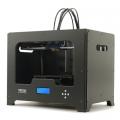Results 11 to 17 of 17
-
11-02-2016, 03:13 AM #11Senior Engineer

- Join Date
- Jun 2014
- Location
- Burnley, UK
- Posts
- 1,662
Don't worry about the overhangs yet, fix the rippling.
You can't fix all at once, you have to change one thing at a time and note the differences.
-
11-02-2016, 05:43 AM #12
-
11-02-2016, 06:21 AM #13Super Moderator

- Join Date
- Jun 2016
- Location
- Oklahoma
- Posts
- 904
Can you share the STL? I'll give it a go and see how it works.
-
11-02-2016, 06:55 AM #14
-
11-02-2016, 10:58 AM #15
If the ripple is the same on all four sides (i.e., truly a ripple and not a shifting between layers), the first thing I'd try is printing with the bed heater off. I'm not familiar with the bed design of that printer, but on another printer some people have determined their print surface flexes as the bed heater cycles on and off. If it flexes, your layer height is effectively changing and some layers get squished more than others, leading to a ripple that looks a lot like what you have. As a test, try something your PLA onto 3M blue painter's tape swabbed with isopropyl alcohol.
If the ripples still appear printing on a cold bed, I'd then print a calibration cube or some other object with a known z-height and measure the height of the final print. If the print result is shorter than it should be, it could be that you're not getting the full z-axis movement out of the z-motors due to binding or something.
From there, I'd use a digital calipers to measure the filament diameter at numerous places and see if it is consistent. If the diameter varies, the amount of extrusion volume you get will be varying with it.
And yeah, shelve the overhang issue until you get the ripple issue figured out.Last edited by printbus; 11-02-2016 at 03:32 PM. Reason: added details
-
11-03-2016, 02:40 PM #16Student

- Join Date
- May 2014
- Posts
- 14
Well, I calibrated both the extruder and the Z axis, and it didnt get rid of the ripples - it simply centered them (so that the back is no longer smooth, and the ripples are the same depth on all four sides). I'm beginning to suspect uneven heating.
All 20mm cubes are, well, 20mm tall - heated or not heated bed.
I know PID has something to do with this and the fact that, despite having more than enough power supply, my bed won't heat above 80c, but again - no simplified "For Dummies" guide to what means what when adjusting PID.
-
11-05-2016, 12:34 PM #17Student

- Join Date
- May 2014
- Posts
- 14
Meanwhile, I have solved my z-wobble.
The Geeetech Prusa I3 has a vertical brace for not only the two outer support rods, but also the vertical screws. I got my trusty dremel out and cut off the brace around the top of the screws, and the z wobble vanished!
printedCubesFixed.jpg
The vertical rippling on the darker, no z wobble cube is from high speed printing... slowed it down and that was gone, too.
Now to figure out the overhang... some artefacts is one thing, looking like someone took red hot steel wool to it is another.




 Reply With Quote
Reply With Quote










Extruder not feeding during print,...
04-24-2024, 01:59 AM in Tips, Tricks and Tech Help